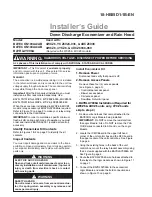
REYQ8~16P8Y1B
VRVIII System air conditioner
4PW39996-1A
Installation manual
3
3.
S
ELECTION
OF
LOCATION
This unit, both indoor and outdoor, is suitable for installation in a
commercial and light industrial environment.
This is a class A product. In a domestic environment this product may
cause radio interference in which case the user may be required to
take adequate measures.
Obtain the customer's permission before installing.
The inverter units should be installed in a location that meets the
following requirements:
1
The foundation is strong enough to support the weight of the unit
and the floor is flat to prevent vibration and noise generation.
2
The space around the unit is adequate for servicing and the
minimum space for air inlet and air outlet is available. (Refer to
and choose one of the possibilities).
■
In case of an installation site where sides A+B+C+D have
obstacles, the wall heights of sides A+C have no impact on
service space dimensions. Refer to
heights of sides B+D on service space dimensions.
■
In case of an installation site where only the sides A+B have
obstacles, the wall heights have no influence on any
indicated service space dimensions.
■
The installation space required as shown in figure 1 is a
reference for cooling operation when the outdoor
temperature is 35°C.
If the outdoor temperature exceeds 35°C or the heat load
exceeds the maximum capacity of the outdoor unit, increase
the distances on the air intake side.
3
Make sure that there is no danger of fire due to leakage of
inflammable gas.
4
Ensure that water cannot cause any damage to the location in
case it drips out the unit (e.g. in case of a blocked drain pipe).
5
The piping length between the outdoor unit and the indoor unit
may not exceed the allowable piping length. (Refer to
"6.6. Example of connection" on page 7
6
Select the location of the unit in such a way that neither the
discharged air nor the sound generated by the unit disturbs
anyone.
7
Make sure that the air inlet and outlet of the unit are not
positioned towards the main wind direction. Frontal wind will
disturb the operation of the unit. If necessary, use a windscreen
to block the wind.
8
Do not install or operate the unit on locations where air contains
high levels of salt, like e.g. in the vicinity of oceans. (Refer for
further information to the engineering databook).
9
During installation, avoid the possibility that anybody can climb
on the unit or place objects on the unit.
Falls may result in injury.
10
When installing the unit in a small room, take measures in order
to keep the refrigerant concentration from exceeding allowable
safety limits in the event of a refrigerant leak.
11
To prevent dripping water to form a puddle underneath the unit,
install a drain pan (available as option kit).
■
Make sure to provide for adequate measures in order
to prevent that the outdoor unit be used as a shelter
by small animals.
■
Small animals making contact with electrical parts can
cause malfunctions, smoke or fire. Please instruct the
customer to keep the area around the unit clean.
If not, the unit may fall over and cause damage or
injury.
A B C D
Sides along the installation site with obstacles
Suction side
Excessive refrigerant concentrations in a closed room
can lead to oxygen deficiency.
■
The equipment described in this manual may cause
electronic noise generated from radio-frequency
energy. The equipment complies to specifications that
are designed to provide reasonable protection against
such interference. However, there is no guarantee that
interference will not occur in a particular installation.
It is therefore recommended to install the equipment
and electric wires keeping proper distances away from
stereo equipment, personal computers, etc...
In places with weak reception, keep distances of 3 m
or more to avoid electromagnetic disturbance of other
equipment and use conduit tubes for power and
transmission lines.
■
In heavy snowfall areas, select an installation site
where snow will not affect the operation of the unit.
■
The refrigerant R410A itself is nontoxic, nonflammable
and is safe. If the refrigerant should leak however, its
concentration may exceed the allowable limit
depending on room size. Due to this, it could be
necessary to take measures against leakage. Refer to
the chapter
"15. Caution for refrigerant leaks" on
■
Do not install in the following locations.
•
Locations where sulphurous acids and other
corrosive gases may be present in the atmosphere.
Copper piping and soldered joints may corrode,
causing refrigerant to leak.
•
Locations where a mineral oil mist, spray or vapour
may be present in the atmosphere.
Plastic parts may deteriorate and fall off or cause
water leakage.
•
Locations where equipment that produces electro-
magnetic waves is found.
The electromagnetic waves may cause the control
system to malfunction, preventing normal
operation.
•
Locations where flammable gases may leak, where
thinner, gasoline and other volatile substances are
handled, or where carbon dust and other
incendiary substances are found in the
atmosphere.
Leaked gas may accumulate around the unit,
causing an explosion.
■
When installing, take strong winds, typhoons or
earthquakes into account.
Improper installation may result in the unit turning
over.
1
Personal computer or radio
2
Fuse
3
Earth leakage breaker
4
Remote controller
5
Cool/heat selector
6
Indoor unit
Summary of Contents for VRVIII REYQ-P8
Page 32: ...4PW39996 1A Copyright Daikin...








































